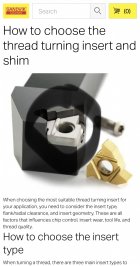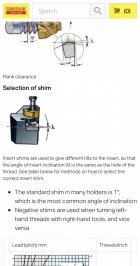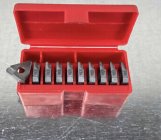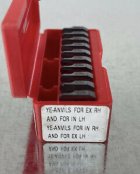Yes @Dusty Stevens , single phase.Is yours single phase as well? Makes threads look just like that.
You are using an out of date browser. It may not display this or other websites correctly.
You should upgrade or use an alternative browser.
You should upgrade or use an alternative browser.
Threading Question
- Thread starter Henryrifle
- Start date
I have put rubber between motor and lathe as well as it was suggested to me. It didn’t help in my case.I have the same lathe, I use cheap carbide inserts at 70rpm. Dark ridgid cutting oil and compound set at 30-29.5 but the last few pass I go strait in with the cross slide to clean up both sides, also I thread at 200RPM the last few passes.
I also put vibration dampers between my motor and lathe, do the 1phase motor doesn’t transfer to the lathe.
Judd
Gold $$ Contributor
Mine is and they do lolIs yours single phase as well? Makes threads look just like that.
I normally finish with a thread file and a burgundy scotchbrite and that combined with small cuts at the end can normally clean them up.
I don’t have the testicular fortitude to thread any faster than 190 tho and I thread toward the shoulder versus away.
WSnyder
Silver $$ Contributor
Commonly known as helix angle. Most every inserted tool I’ve had comes with the correct shim for the most common thread pitches and material diameters. All the tool manufacturers have charts to help pick the correct shim. There are times you may need a negative shim. Negative shims are used when turning left-hand threads with right-hand tools, and vice versa. If you’ve never looked at this (helix angles in thread turning) it might pay to familiarize yourself with it.it provides it the right angle of approach
Walt Krafft
Gold $$ Contributor
I stopped using threading tools that needed shims 30 years ago.
Watch a joe Pie threading video on YouTubeMine is and they do lol
I normally finish with a thread file and a burgundy scotchbrite and that combined with small cuts at the end can normally clean them up.
I don’t have the testicular fortitude to thread any faster than 190 tho and I thread toward the shoulder versus away.
He threads away from shoulders so timing is a non issue
It’s really easy if you can run your lathe in reverse.
I run a hardinge HLV and it has a easy to set stop so threading is incredibly easy with them.
Oughta' try that with a chuck threaded on the spindle...... Make sure and wear your armour and crash helmet.Watch a joe Pie threading video on YouTube
He threads away from shoulders so timing is a non issue
It’s really easy if you can run your lathe in reverse.
I run a hardinge HLV and it has a easy to set stop so threading is incredibly easy with them.
Yea, that could get exciting!Oughta' try that with a chuck threaded on the spindle...... Make sure and wear your armour and crash helmet.
Lol!
WSnyder
Silver $$ Contributor
The shim is the insert under the insert on your indexable laydown thread tool holder. It’ll have a reference number on it.Shims. You guys are using shims?
Sandvik Coromant


Last edited:
The shim supports the carbide right up to the cutting edge…
Rigidity is always good… and when you have a ‘screw down‘ insert at the end of a tool … well they put the shim there to support it more soundly…
Yeah I knew the rake / angle thing - but a man has to leave something for the editors…
it’s the Internet Dern it … lol..
Rigidity is always good… and when you have a ‘screw down‘ insert at the end of a tool … well they put the shim there to support it more soundly…
Yeah I knew the rake / angle thing - but a man has to leave something for the editors…
it’s the Internet Dern it … lol..
Dusty Stevens
Shiner
What theyre saying is the modern designs do not use the shimsThe shim supports the carbide right up to the cutting edge…
Rigidity is always good… and when you have a ‘screw down‘ insert at the end of a tool … well they put the shim there to support it more soundly…
Yeah I knew the rake / angle thing - but a man has to leave something for the editors…
it’s the Internet Dern it … lol..
Judd
Gold $$ Contributor
I’ve seen his video…just not something I’ve tried/experimented with and I’ve got a D1-5 chuck so I could run in reverse.Watch a joe Pie threading video on YouTube
He threads away from shoulders so timing is a non issue
It’s really easy if you can run your lathe in reverse.
I run a hardinge HLV and it has a easy to set stop so threading is incredibly easy with them.
LVLAaron
Gold $$ Contributor
I’ve seen his video…just not something I’ve tried/experimented with and I’ve got a D1-5 chuck so I could run in reverse.
Make sure your carriage isn't going to "lift" off your ways.
xr650rRider
Silver $$ Contributor
Make sure your carriage isn't going to "lift" off your ways.
If that happens, you probably shouldn't be using a lathe.
ronsatspokane
Gold $$ Contributor
The lay down threading tool I use has the shim as well. It cuts very clean threads. It is a newer tool. Maybe 4 years old. When I first got it I wondered what was going on. The shim looks like a cutting tool. It is just a support for the cutter.The shim supports the carbide right up to the cutting edge…
Rigidity is always good… and when you have a ‘screw down‘ insert at the end of a tool … well they put the shim there to support it more soundly…
Yeah I knew the rake / angle thing - but a man has to leave something for the editors…
it’s the Internet Dern it … lol..
LVLAaron
Gold $$ Contributor
If that happens, you probably shouldn't be using a lathe.
Not all carriages are on the ways with much more than the weight of the carriage. It's meant for downward pressure... so you lift up on it with an upside down tool and I'd say you're more apt to chatter than before.
Similar threads
- Replies
- 21
- Views
- 5,185
- Replies
- 43
- Views
- 2,046
- Replies
- 42
- Views
- 1,432
Upgrades & Donations
This Forum's expenses are primarily paid by member contributions. You can upgrade your Forum membership in seconds. Gold and Silver members get unlimited FREE classifieds for one year. Gold members can upload custom avatars.

Click Upgrade Membership Button ABOVE to get Gold or Silver Status.
You can also donate any amount, large or small, with the button below. Include your Forum Name in the PayPal Notes field.
To DONATE by CHECK, or make a recurring donation, CLICK HERE to learn how.

Click Upgrade Membership Button ABOVE to get Gold or Silver Status.
You can also donate any amount, large or small, with the button below. Include your Forum Name in the PayPal Notes field.
To DONATE by CHECK, or make a recurring donation, CLICK HERE to learn how.











